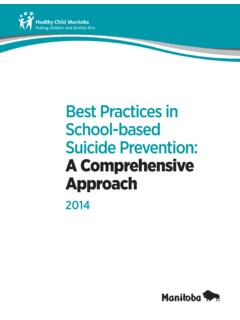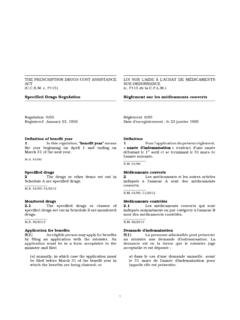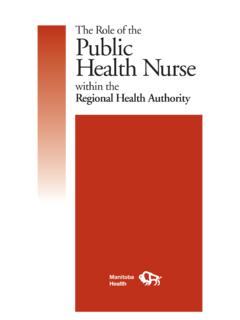Transcription of SOCIAL PARTICIPATION AND ITS BENEFITS - Province of …
1 SOCIAL PARTICIPATION AND ITS BENEFITSR eport Prepared by:Sheila NovekVerena MenecTanya TranSheri BellAugust 2013 The Centre on Aging, established on July 1, 1982 is a university-wide research centre with a mandate to conduct, encourage, integrate, and disseminate research on all aspects of further information contact:Centre on Aging, University of Manitoba 338 Isbister Building Winnipeg MB R3T 2N2 CanadaPhone: | Fax: Email: | Web site: to cite this report:Novek S, Menec V, Tran T, Bell S. Exploring the Impacts of Senior Centres on Older adults . Winnipeg, MB: Centre on Aging, May 2013. Centre on Aging This report may be reproduced, in whole or in part, provided the source is credits: Seniors in gym Health Canada Seniors sitting 123RF Stock Photos_Qi FengThis report was funded by the Manitoba Seniors and Healthy Aging PARTICIPATION AND ITS BENEFITSR eport Prepared by:Sheila NovekVerena MenecTanya TranSheri BellAugust iTABLE OF CONTENTSE xecutive Summary.
2 1 Exploring the Impacts of Senior Centres on Older adults ..7 What is this report about? ..7 SOCIAL PARTICIPATION ..9 The impact of SOCIAL PARTICIPATION on health ..9 Senior centres ..12 The BENEFITS of senior centre PARTICIPATION ..13 Limitations of current senior centre research ..16 Section 2: Interviews with older adults ..17 Methods ..17 Participants ..17 Health and well-being profile of participants ..19 Attending the senior centre ..21 Perceived BENEFITS of attending a senior centre: Quantitative findings ..22 Older adults perspectives on the BENEFITS of attending senior centres: Qualitative findings ..26 Positive features that enhance senior centre PARTICIPATION ..37 Challenges that impact senior centre PARTICIPATION ..40 Section 3: Interviews with directors and program coordinators of senior centres ..43 Methods ..43 Perceived BENEFITS of senior centres ..43 What are the biggest challenges senior centres face?
3 44 Evaluating the impacts of senior centres ..45 Pertinent information ..46 Potential issues and challenges ..46 Section 4: Recommendations for developing tools to evaluate senior centres ..47 Section 5: Discussion ..49 Section 6: conclusions ..55 References ..57II UNIVERSITY OF MANITOBA, CENTRE ON AGINGA ppendix: Examples of possible evaluation tools ..63 Facility tool ..63 Membership tool ..65 Program evaluation tool ..67 Centre satisfaction tool ..69 Outcome evaluation iiiLIST OF TABLEST able 1: Demographic profile of participants ..18 Table 2: Logic model of senior centre outcomes ..48 LIST OF FIGURESF igure 1: General health questions ..19 Figure 2a: Has someone to listen to ..20 Figure 2b: Loneliness ..21 Figure 3: Activities participants engaged in at the senior centre once a month or more ..22 Figure 4a: Perceived BENEFITS of senior centre psychological ..23 Figure 4b: Perceived BENEFITS of senior centre SOCIAL BENEFITS .
4 24 Figure 4c: Perceived BENEFITS of senior centre mental health ..24 Figure 4d: Perceived BENEFITS of senior centre physical health ..25 Figure 5: Satisfaction with senior centre .. 1 EXECUTIVE SUMMARYB ackgroundThe Centre on Aging was contracted by the Manitoba Seniors and Healthy Aging Secretariat to examine the BENEFITS of SOCIAL PARTICIPATION on the health and well-being of older adults , as well as the role senior centres might play in promoting the health and well-being of older adults who use project had two aims:1. To examine the BENEFITS of SOCIAL PARTICIPATION in general, as well as the BENEFITS of seniors centres by conducting a review of existing research, and by interviewing older adults who attend senior To make recommendations for a tool (or tools), based on the literature review, interviews with older adults , and directors or program coordinators of senior centres, that could be used in the future to evaluate the impacts of senior centres.
5 MethodsThe present report is based on three components:1. A review of the existing research on the BENEFITS of SOCIAL PARTICIPATION in general, and the BENEFITS of senior centres Interviews with 60 older adults who attended five senior centres in and outside of Winnipeg. Interviews were conducted in person at senior centres between May and December 2012. A variety of questions were asked about individuals PARTICIPATION in activities and the impact that the senior centre had on their lives. 3. Interviews with 10 directors and program coordinators of senior centres in Manitoba explored their views of the impacts of senior centres and the usefulness of an evaluation tool or tools. 2 UNIVERSITY OF MANITOBA, CENTRE ON AGINGF indingsThe BENEFITS of SOCIAL participationA large body of literature shows that SOCIAL PARTICIPATION is associated with better mental and physical health. The following provides a snapshot of some research findings: For every 1 point decrease on a SOCIAL activity scale, there was a 33% more rapid rate of decline in motor function ( , grip strength, muscle strength) within an average of five years (Buchman et al.)
6 , 2009) The risk of developing a disability in activities of daily living decreased by 43% over an average of 5 years for each additional SOCIAL activity engaged in; the risk of mobility disability decreased by 31% (James et al., 2011) Among older adults with depression, those who were highly socially active were over times more likely to have improvements in their depressive symptoms 2 years later than those with low SOCIAL activity (Isaac et al., 2009) An intervention that combined structured SOCIAL activity with light-intensity exercise ( , card games, croquet) significantly improved older adults memory function and sleep (Naylor et al., 2000) The rate of cognitive decline was reduced by an average of 70% in older adults who were frequently socially active compared to those who were infrequently socially active over an average of 5 years. (James, Wilson, Barnes, & Bennet, 2011) Older adults who participated on a daily or weekly basis in SOCIAL activity had a 40% reduced risk of developing dementia compared those who were not socially engaged (Wang, Karp, Winblad, & Fratiglioni, 2002) Older women who participated in organizational activities or study circles had half the likelihood of dying within a twelve year time period compared to those who did not participate in these SOCIAL activities (Agahi & Parker, 2008) 3 The BENEFITS of senior centresResearch on senior centres demonstrates that PARTICIPATION is associated with SOCIAL , mental, and physical health BENEFITS .
7 Senior centres promote health by providing health and support services, encouraging active and healthy aging, and by fostering a SOCIAL environment that is conducive to SOCIAL PARTICIPATION and well-being. Senior centres are also ideal venues for health promotion interventions, such as falls prevention, influenza vaccines, diabetes management, and so forth. Key findings from our interviews with older adults are: Virtually all participants felt that the activities they engage in almost always or often give them a sense of accomplishment. 80% or more also felt that the activities increased their knowledge, helped them gain self-confidence, and provided an opportunity to try new things. The vast majority of participants thought that the activities provided them with SOCIAL BENEFITS , allowing them to socially interact, be part of a community, and develop close relationships. 88% of participants indicated that it is almost always or often true that the activities help them stay healthy.
8 The vast majority of participants also indicated that the activities contribute to their emotional well-being (90%), and help them to relieve stress (85%).90% of participants indicated that the activities contribute to their emotional well-being and 85% reported that the activities help them to relieve stress. Research (James et al., 2011) suggests that if we could increase older adults activity level by one SOCIAL activity, we could reduce the proportion of people with ADL disabilities from 38% to a decrease. Put another way, for every 7 older adults who increase their SOCIAL activity level, one person would remain disability-free within about a 5-year time frame. We would further reduce the proportion of older adults who develop a mobility disability from 62% to 43% - a 19% decrease. In other words, for every 6 older adults who increase their SOCIAL activity level, one person would not develop mobility UNIVERSITY OF MANITOBA, CENTRE ON AGING Opportunities to stay active and socially engaged helped several participants cope with mental illness and addictions.
9 Senior centres promoted older adult health by providing opportunities for physical activity and access to health information, education and health services. Senior centres offered a range of educational opportunities that promoted learning, creativity, and skills development. Volunteering opportunities enabled older adults to socialize, contribute to their communities, and share their knowledge and skills. Potential uses for senior centre evaluation toolsThe literature review, interviews with older adults , and interviews with directors and program coordinators of senior centres suggested that a range of information would be useful for evaluating senior centres. For example, it may be of interest to find out how many volunteers are involved in a senior centre, how many seniors attend a particular activity program ( , an exercise class), or whether attending a senior centre has physical or mental health BENEFITS .
10 It gives me a chance to get out of where I m living and to enjoy the friendships of the friends that I ve made here. Everybody is so friendly, it s such a wonderful feeling that I look forward to Wednesdays, you have no idea. This has kept me above ground, you know, from getting totally depressed. Cause I would be sitting in the house doing nothing. It certainly filled a large void in my life following my husband s death. And I believe it contributed to my recovery from that depressive state. 5 Directors and program coordinators of senior centres identified a number of possible uses for evaluation tools, including: Program planning; Identify problems with programs, services or facility; Improving retention of members; Identifing and eliminating barriers for participants; Finding out if people stop attending and reasons why they did not return; and Obtaining funding Conclusions Research demonstrates the BENEFITS of SOCIAL PARTICIPATION to older adults physical and mental health.













